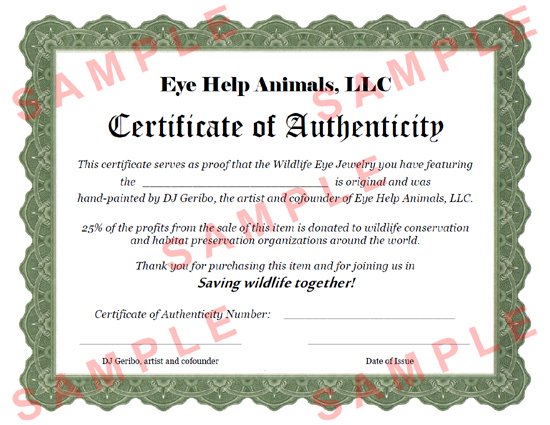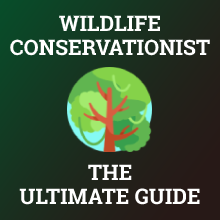What is a Wildlife Conservationist?
For a Wildlife Conservationist, helping animals and their habitats is number one.
These incredible souls preserve wildlife areas and help animals to safely stay where they are.
Some of the things that you can find a Wildlife Conservationist doing include keeping habitats disease-free and ensuring that fires or other disasters do not start in that area.
Not only will you head out into the field to do this career, but you will spend time doing lab research and studying science as well.
Duties
Being a Wildlife Conservationist is not an easy task, but it is a job worth doing.
If you are interested in becoming a Wildlife Conservationist, you may wonder what a typical day could bring.
Here are some of the things that you can expect to do as a Wildlife Conservationist:
- Surveying aspects of nature
- Data collection
- Helping gauge population sizes
- Educating others
- Making decisions about how to maintain an area
Salary
On average in the United States, a Wildlife Conservationist will make around $67,000 a year.
In places where there are a higher amount of wildlife and more opportunities for conservation, a Wildlife Conservationist can make over $100,000 a year.
Depending on the state that you work, your salary may vary as well.
Wildlife Conservationists who work in West Virginia make around $50,000 a year.
While those who work in states like Massachusetts and Alaska can make over $80,000 a year.
There is a need for Wildlife Conservationists all over the world, so even working in a rainforest could bring you a fantastic salary.
Annually National Average Salary: $77,920
Average Annual Salary by State
| State | Avg. Annual Salary |
|---|---|
| Alabama | $66,520 |
| Alaska | $86,060 |
| Arizona | $73,840 |
| Arkansas | $73,040 |
| California | $91,460 |
| Connecticut | $76,850 |
| Florida | $59,600 |
| Georgia | $70,690 |
| Hawaii | $84,060 |
| Idaho | $74,970 |
| Illinois | $80,240 |
| Indiana | $56,540 |
| Iowa | $82,770 |
| Kansas | $64,560 |
| Kentucky | $60,010 |
| Louisiana | $87,260 |
| Maine | $72,160 |
| Maryland | $95,790 |
| Massachusetts | $98,390 |
| Michigan | $79,550 |
| Minnesota | $72,870 |
| Mississippi | $94,330 |
| Missouri | $82,200 |
| Montana | $75,210 |
| Nebraska | $59,920 |
| Nevada | $64,230 |
| New Hampshire | $69,960 |
| New Jersey | $86,480 |
| New Mexico | $71,990 |
| North Carolina | $69,550 |
| North Dakota | $80,440 |
| Ohio | $74,870 |
| Oklahoma | $60,150 |
| Oregon | $84,550 |
| Pennsylvania | $72,360 |
| Rhode Island | $97,070 |
| South Carolina | $65,600 |
| South Dakota | $65,880 |
| Tennessee | $65,370 |
| Texas | $62,310 |
| Utah | $70,090 |
| Vermont | $77,050 |
| Virginia | $71,720 |
| Washington | $90,370 |
| West Virginia | $75,380 |
| Wisconsin | $68,840 |
| Wyoming | $70,200 |
| Puerto Rico | $50,670 |
Annual Average Salary: Top 5 States
The top earning state in the field is Massachusetts, where the average salary is $98,390.
These are the top 5 earning states in the field:
* Employment conditions in your area may vary.
How to Become a Wildlife Conservationist
Step 1Earn a Degree
It’s very important that a Wildlife Conservationist has a Bachelor’s degree.
This is so that the employers and clients know that the person doing the job knows what they are doing.
Some of the common degrees that many Wildlife Conservationists earn include:
- Environmental science
- Biology
- Animal sciences
- Agricultural science
- Wildlife biology
Most Bachelor’s degrees can be earned in about four years.
While earning a Bachelor’s degree, many aspiring Wildlife Conservationists volunteer or work internships with local wildlife programs to learn more about the job.
This can be good for Wildlife Conservationists, as they are able to gain on the job knowledge while still studying for their degree.
Having some experience before entering the workforce will provide great examples of a resume.
Step 2Gain Experience
After you earn a Bachelor’s degree in one of the above-mentioned categories and have volunteered with your local wildlife program, it’s time to think about earning a paycheck.
Most Wildlife Conservationists will have experience before they become employed, but this is the time to decide your niche and what kind of work you want to do as a Wildlife Conservationist.
Some of the areas that a Wildlife Conservationist may decide to look into are:
- Ecological Consultant
- Landscape Conservationist
- National Park Conservationist
- Wildlife Educator
- Wildlife Biologist
- Wildlife Manager
When it comes to this career, it really depends on what type of wildlife you want to work with.
Some Wildlife Conservationists work with fish and sea animals, while others work with deer and forest animals.
Some Wildlife Conservationists don’t work with animals at all, instead, they deal with trees, plants, and water.
Step 3Become Certified
After having a few years of experiencing work in the field of Wildlife Conservation, it’s time to make it official.
Even though it is not a legal requirement to have a certification in Wildlife Conservation, it’s important to have these types of credentials for potential employers as well as clients.
There are two credentials from The Wildlife Society that are accredited across the United States:
- Associate Wildlife Biologist
- Certified Wildlife Biologist
An Associate Wildlife Biologist is someone who has the education and knowledge to work in Wildlife Conservation.
All you have to do is submit your transcripts and an application to The Wildlife Society.
This certification is good for ten years and cannot be renewed.
Instead, a person who wants to earn another certification should obtain the Certified Wildlife Biologist certification.
A Certified Wildlife Biologist can also show their education, but they have the expertise from hands-on experience as well.
This certification can also be obtained through an application, transcripts, and providing work experience details.
This certification is good for 5 years, and after that, it must be renewed.
Step 4Continue Your Education
After many years of experience working as a Wildlife Conservationist, you may find that it’s time to continue educating yourself.
There are a few different ways that can be done as a Wildlife Conservationist.
The most obvious would be to earn a Master’s degree.
This takes around two years to complete, and oftentimes there are programs available online.
Some of the jobs you can expect with a Master’s degree include:
- Conservation scientist
- Environmental scientist
- Forester
- Microbiologist
- Wildlife biologist
It’s also possible to gain an education in other ways in this field.
This can be done by working in other niches, to see what other Wildlife Conservationists do.
It could also mean attending seminars or webinars to explore more about Wildlife Conservation.
As long as you continue to learn, this job will never get boring.
Education
A Wildlife Conservationist must be well-educated, which means a Bachelor’s degree is required in order to gain most jobs in this field.
Unlike many other careers, there are several types of majors that can help you gain employment as a Wildlife Conservationist.
Some of the most popular majors among prospective Wildlife Conservationists today include:
- Agricultural Science
- Environmental Science
- Forestry
- Rangeland Management
- Wildlife Biology
It’s important to get an education in life sciences for this career, many of the classes that you can expect to take in these fields are:
- Environmental Issues
- Statistics for Environmental Professionals
- Planning and Responding to Natural Disasters
- Biology
- Math for Environmental Professionals
- Conservation
- Geographic Information Systems
- Field Data Collection
- Natural Resource Law and Policy
A Bachelor’s degree will get you an entry-level job as a Wildlife Conservationist, so if you’d like to become more specialized it’s important to earn a Master’s degree.
A Master’s degree is a degree that shows how dedicated you are to the industry you work in.
Many Master’s degrees take around two years to complete, but there may be some accelerated ones that take around 18 months.
Some of the types of Master’s degrees that work great for Wildlife Conservationists are:
- Wildlife Conservation
- Wildlife Ecology
- Zoology
- Fisheries and Wildlife
- Entomology
- Fish and Wildlife Pathology
Often times, a Master’s degree program will not admit students who do not have experience in the field that they are studying.
This means that it’s important to gain hands-on experience as a Wildlife Conservationist before attending a Master’s degree program.
Once a Masters level degree is earned, some of the jobs that may be available include:
- Soil Scientist
- Range Technician
- Wetlands Restoration Specialist
- Outdoor Recreation Planner
- Agriculture Research Worker
- Shooting Preserve Manager
It’s important to decide for yourself what niche you want to pursue in this field.
After gaining a Master’s degree, more career advancement opportunities become available.
Video About The Career
Certification
There are two levels of certification for Wildlife Conservationists.
When just starting out in the career, many Wildlife Conservationists apply for the Associate Wildlife Biologist certification.
In order to be eligible for this certification, you must have a Bachelor’s degree in an appropriate subject.
There are some other things that you will need to do in order to gain certification, which include:
- Complete the appropriate application form
- Submit transcripts
- Submit supporting materials (work experience etc.)
- Pay the application fee
Once you send in your application, it can take up to six months to hear whether you have been certified or not.
The application form is considerably long and requires a lot of information about you.
There are specific courses that you must take in order to be eligible for this certification, they are listed in the application, but these courses include:
- Wildlife Management
- Wildlife Biology
- Ecology
- Zoology
- Botany
- Physical Sciences
- Statistics
- Quantitative Sciences
- Humanities and Social Sciences
- Policy, Administration, and Law
This certification is good for ten years and cannot be renewed.
Once the ten years are up, a person can earn the Certified Wildlife Biologist credential, which will showcase expertise in the field.
The same application requirements apply for this certification, and it is good for five years.
The course requirements are the same for this certification, the only difference is the fee and education information.
This certification is renewable and can be done by providing proof of at least 80 hours of continued education in wildlife conservation and reapplying by mail or online.
The application fee for the Associate Wildlife Biologist certification is around $115.
The Certified Wildlife Biologist certification costs around $155.
After obtaining a certification, there are many benefits.
Certification provides proof that you have competence in the field and will provide many more career opportunities in the future.
Certification Example:

Average Training Program Duration: 4+ Years
There is no official training program when it comes to working as a Wildlife Conservationist.
The best way to get experience in this field is to work in it.
This means volunteering, interning, or doing other work in order to keep up with conservation and wildlife issues.
Most Wildlife Conservationists who want to become certified can do it right away, as long as they have the education to show for it.
For those who want to earn the Certified Wildlife Biologist, providing proof of continued education is enough.
Popular Programs
Earn your accredited, affordable Wildlife Forestry and Conservation career diploma online with Penn Foster in as little as 4 months!
Job Outlook
Wildlife Conservationist jobs won’t be growing much in the next ten years, but at around 4 percent, the growth of this career isn’t too bad.
With the growth of the human population, there is a greater need to cut down more forests and other wildlife areas.
While this helps people build homes, it cuts down on the places that wildlife can live unbothered.
Those that are interested in this career should think about learning practical knowledge through internships, summer jobs, and volunteer work.
This is preferable to employers so that they know you have the competence to do the job correctly.
For Wildlife Conservationists with experience, the job opportunities are much more abundant than for Wildlife Conservationists who are starting from scratch.
Employment Growth Projection: 4%
2023
2033
That's a higher than average projected growth of 800 jobs.
Wildlife Conservationist: Interest Over Time
Should You Become a Wildlife Conservationist?
Overall Satisfaction: High

This seems to be a very satisfying career for people who enjoy the outdoors and are looking to help make the world a better place.
It seems that people who work as Wildlife Conservationists love their jobs because they are doing good for the planet as well as animals.
Not only that, but they say that the pay is great, and the hours are flexible.
The fact that a Wildlife Conservationist days never look the same is a plus for many who enjoy this career.
For those that are working in more rural areas, the pay could be a bit smaller, which can cause a little less satisfaction for some.
Average Salary: High

On average, Wildlife Conservationists who work in the United States make around $67,000 a year.
This isn’t the story for Wildlife Conservationists who are just starting out in their careers.
The career for a new Wildlife Conservationist without much experience is around $50,000 a year.
Wildlife Conservationists who have a degree, many years of experience, and certifications can make over $100,000 a year in some areas.
Having a career in a place with more endangered species or forests will likely allow for a higher pay scale.
Job Growth Outlook: Low

This career is estimated to grow around 4 percent within the next ten years.
This is due to the population number growing over time, and the amount of space needed to house billions of humans.
There should still be a need for Wildlife Conservationists, especially for hunting areas, sightseeing, and conserving of marshes and wetlands.
Wildlife Conservationists will be needed to research and enact several studies for migrating birds and displaced wildlife as well over the next decade.
It’s important for the world to have Wildlife Conservationists, to protect and combat issues with our natural resources.
Education Duration: 4+ Years

In order to become a Wildlife Conservationist, you must first have a Bachelor’s degree.
In the United States, the average Bachelor’s degree takes about four years to finish.
After taking courses that pertain to your field of study, you may need to take elective classes to fulfill graduation requirements.
For those who want to earn a Master’s degree, this can take about another two years to finish.
So, all in all, it can take about 7 years to become a Wildlife Conservationist.
Personal Skills Needed

It’s important to have a love for animals and nature to work as a Wildlife Conservationist.
Some of the other essential skills needed for this career include:
- Listening skills
- Verbal and written communication skills
- Problem-solving skills
- Critical thinking skills
- Ability to work alone and with a team
- Analytical skills
- Researching skills
Every skill that you have as a Wildlife Conservationist will come in handy, whether talking with humans or working with animals, it’s important to have interpersonal skills and the ability to analyze and assess a situation.
Frequently Asked Questions
Q. What is the average salary for a Wildlife Conservationist?
The salary for a Wildlife Conservationist can vary depending on where in the United States you work, and how many years you’ve worked in the field.
The average salary in the United States is around $67,000 a year.
However, don’t expect this when just starting out in this career.
The beginning salary for a Wildlife Conservationist is closer to $50,000 in some areas.
It’s possible to make over $100,000 as a Wildlife Conservationist, especially when working in large forests or wildlife conservatories.
Q. How long does it take to become a Wildlife Conservationist?
In order to work as a Wildlife Conservationist, you must at least have a Bachelor’s degree.
It can take around four years to finish a Bachelor’s degree, but some people can find accelerated programs that may not take as long.
For Wildlife Conservationists who are interested in learning, even more, a Master’s degree is available.
This can take around two years to finish.
On average, it can take anywhere from four to six years to become a Wildlife Conservationist.
Q. What does a Wildlife Conservationist do?
A Wildlife Conservationist makes sure that all habitats for animals are being taken care of.
This could be on a local, state, or even federal level in some areas.
Some of the things that a Wildlife Conservationist might do is check the soil of an area, make sure that it is not becoming over-hunted, and checking for the disease in a certain location.
Days are never the same for a Wildlife Conservationist, so this job is perfect for anyone with a sense of adventure and a love for animals.
Q. What is the demand for Wildlife Conservationists?
Since there will hopefully always be forests, wetlands, and other wildlife sanctuaries, there will always be a need for Wildlife Conservationists.
However, this career will not grow over the next decade as much as many other careers in this field.
This is due to the rising population, and the cutting down of forests and other areas in order to create housing for humans.
If you are interested in working as a Wildlife Conservationist, now is the time to check out the career.
Q. How much does it cost to become a Wildlife Conservationist?
Since you have to have a Bachelor’s degree in order to work as a Wildlife Conservationist, it can cost anywhere from $15,000 to $30,000 to earn an education.
Depending on where you go to school, and whether that school is public or private, the tuition can vary.
Also, for those who are interested in pursuing a Master’s degree, this can cost anywhere from $20,000 to $40,000 on its own.
All in all, it can cost anywhere from $35,000 to $70,000 to become a Wildlife Conservationist.










Is wildlife conservationist program available for international students? . I’m 34 year old man from Egypt . I’m keen on watching animal documentaries and wildlife especially in African Savannah like Tanzania, Kenya and Botswana. I also follow some outstanding wildlife photographers and film makers such as , Kim Wolhuter and Steve Irwin . Therefore, kindly let me know if i can join this program or not , additionally i want to inform you that my English Level (CEFR ) is B2 .
Finally , I’m a logistics and international transportation graduate